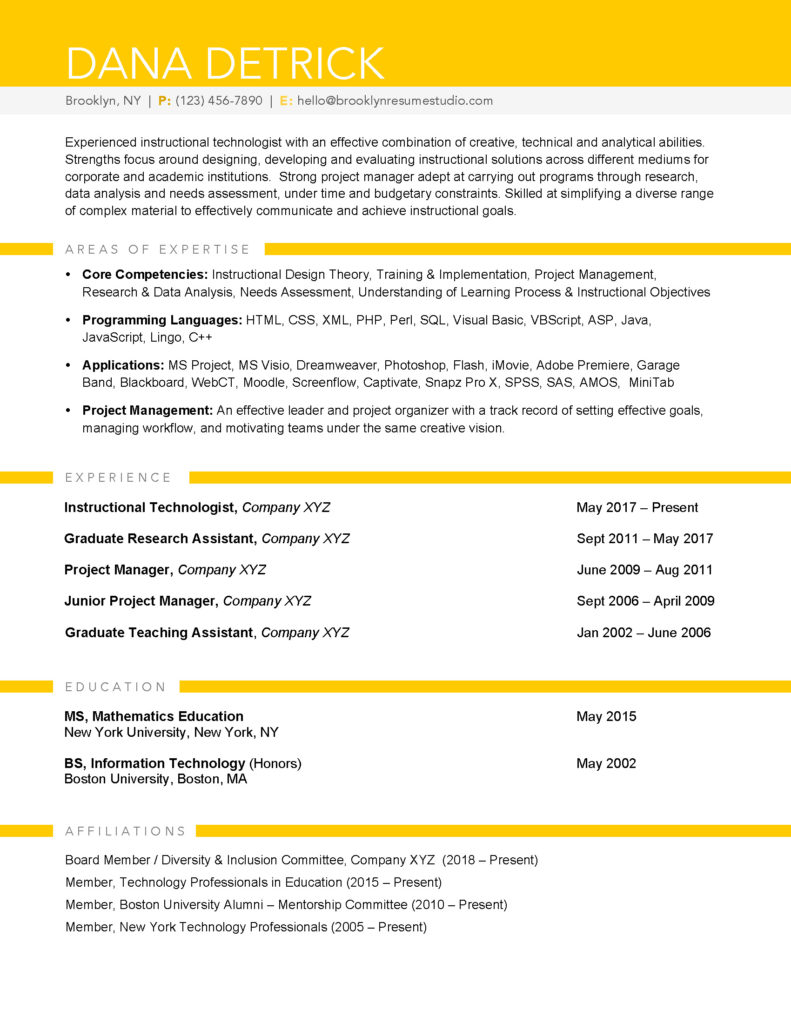
There are generally 3 types of resume formats, each of which serve a different purpose. When selecting the best resume format for your CV, it’s important to understand the benefits and disadvantages of each in order to ensure the best results.
The traditional Chronological Resume is what you picture in a typical CV, where your experience is listed out with dates, titles, and employers starting with the most recent and working backwards.
The Functional Resume focuses more on skills and less on timelines. In some cases, the functional resume leaves off details altogether and just shows the dates of employment alongside titles and employers. This is typically used when a job applicant’s prior experience is less relevant to the job they’re applying to – hence less detail around responsibilities, and more focus on transferrable skills.
A Hybrid Resume is a combination of the two – and typically includes both the detailed employment history in chronological order (and based on relevancy), as well as emphasis on skills and areas of expertise.
For now, let’s focus on the Functional Resume format and its uses.
What is a Functional Resume?
A functional resume emphasizes skill sets over direct work experience or timelines. A traditional (or chronological) resume will list out each role with a detailed description of responsibilities and accomplishments. Whereas a functional resume often includes a very brief or even no description of day-to-day responsibilities, detailing only the job title, company name, and dates of employment.
A traditional resume can sometimes include a summary or objective statement. But a functional resume takes that a step further by providing more detail and context around how the candidate has utilized skills, often with specific examples. This is the primary focus of the resume and can span anywhere from several bullet points to several paragraphs.
When to Use a Functional Resume
It’s not always about having the right experience – skills play a large role in whether or not a candidate will be a good fit for a job. A functional resume is used most often when a candidate lacks direct experience in the area they’re applying to but wants to emphasize the transferable skill sets they have that would still make them a good fit for the role.
The term “transferable skills” refers to experience, skill sets, or attributes that can be transferred from one job to another regardless of industry or specialty.
Transferable Hard Skills
Say, for instance, a job seeker is targeting an entry-level programming role. While they’ve never specifically held the role/job title of programmer, they do bring the required knowledge in coding languages like HTML, CSS, and JavaScript. Perhaps they’ve taken classes on the side, or are self-taught, but they don’t have direct experience using these hard skills in a professional environment.
Transferable Soft Skills
A functional resume is also a great tool for communicating transferable soft skills. These skills are those which can add value to multiple types of jobs or industries, without being too specific to the candidate’s current or most recent role(s). Examples of transferable skills could include relationship building, communication, management experience, or public speaking.
When Not to Use a Functional Resume
Functional resumes are less effective in situations where a hiring manager is looking for direct, hands-on experience. In some cases, it may simply be required for the role, and hiring someone without this experience is risky for the organization.
In this case, the hybrid resume format can be effective as a middle ground between the traditional chronological format and the functional resume format. The hybrid resume still emphasizes skills but provides some context around their current and previous work experience.
A hybrid resume will still have a strong summary section and overview of the candidate’s (transferable) skills, while also providing high-level details around the responsibilities and accomplishments within their work experience.
Tips to Create a Functional Resume
Whenever you’re creating a resume, have a clear idea of the types of roles you’re targeting. This includes job titles, the level of experience, and types of companies that interest you. Search for relevant job descriptions and pay attention to the top criteria that the role calls for, whether it’s particular skill sets, experience, or personal attributes.
Zero in on the skill sets you do have and emphasize these most heavily in the resume. Create a strong opening summary (3-5 lines or bullet points) that serves as a branding statement. This statement is much like your elevator pitch – so ask yourself, what is the main message you’re trying to convey to hiring managers?
Next, identify the top 5-6 skills that you bring to the table, ideally those which are also relevant to the jobs you’re applying to. Create a separate skills section that speaks to each of these. You can use short paragraphs or bullet points, ideally providing an example of when you’ve used each of those skills in a previous capacity, or to elaborate on why they’re a strength.
For example:
Relationship Building | Proven success building strong relationships with clients and team members to ensure deadlines are met.
Following your Skills section is the Experience section. List each of your roles in reverse chronological order, starting with the most recent. Include the company name, job title, location, and dates of employment. You can opt to include a brief sentence or two about your role, but avoid going into too much detail, especially if the responsibilities aren’t related to the types of jobs you’re targeting.
Finally, include any additional sections such as your Education, Professional Affiliations, or anything else that might be relevant to your reader. This could include software or language skills, volunteer work, or additional training. Be sure to emphasize any kind of training or outside work that may be relevant to the roles you’re targeting.
 Mistakes to Avoid When Writing a Functional Resume
Mistakes to Avoid When Writing a Functional Resume
The biggest mistake people make when creating a functional resume is providing too much content that is unrelated, or not enough detail to accurately portray their qualifications. Leaving off your job experience altogether would be confusing to a hiring manager, as would providing extensive detail that’s not relevant to the job.
Other mistakes would be not tailoring the resume effectively to the role you’re applying to, and emphasizing skills that are not relevant to the job.
Finally, it’s not necessary to include EVERYTHING in a resume. Think of a resume as a high-level introduction that’s meant to provide the top-selling points, based on what your reader will find interesting and relevant.
Particularly for a functional resume, focus on the skills you have that would enable you to succeed in the role you’re applying for. It’s not necessary to include every job you’ve held. You may opt to leave off positions that are more than 10-12 years back, depending upon your level of experience.
The rule of thumb for all resumes is relevance. Focus solely on communicating the information that will be most relevant to your audience. What skills and experience do you bring to the table that make you a good fit for the role? Communicate those effectively in a way that’s concise and easy to understand.
Not sure what type of resume is best for your situation? Contact us to recommend a package that best fits your needs.
